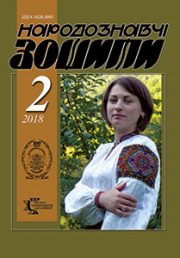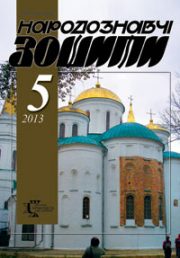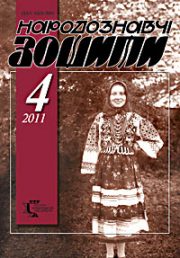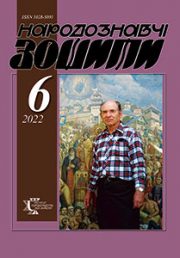The Ethnology Notebooks. 2021. № 6 (162), 1507—1535
UDK 398.1:81’374.2(477.41/.42)
DOI https://doi.org/10.15407/nz2021.06.1507
VASIANOVYCH Oleksandr
- ORCID ID: https://orcid.org/0000-0001-9360-6447
- Сandidate of History (Ph. D),
- Deputy Director for Research,
- State Scientific Center for Protection of Cultural Heritage
- from Technological Disasters,
- 56, ave. Peremogy, 03057, Kyiv, Ukraine
- Contacts: e-mail: guru_v@ukr.net
Abstract. Introduction. The agricultural nature of the economic activities of the inhabitants of the Right-Bank Polissya predetermined the complete dependence on the natural and climatic conditions of the successful implementation of agricultural work, and consequently the well-being of a peasant. Trying to ensure the harvest and avoid undesirable weather phenomena, the Polischuks widely used magical protective means, numerous taboos and restrictions on certain types of work on the relevant days. However, under the influence of the rapid development of education, a general increase in the cultural level, the consciousness of the population of Polissya villages is constantly enriched with scientific knowledge, leading to the smoothing of traditional folk beliefs and ideas. Therefore, the compiling of the vocabulary of terms and terminological local variants associated with folk meteorological beliefs is very relevant now.
Problem Statement. The analysis of the collected field data, which reflect not only the realities of traditional household culture, but also their terminology, led to the need to systematize the meteorological material by compiling an appropriate dictionary.
Purpose. Compiling of a dictionary of meteorological beliefs of the inhabitants of the Right-Bank Polissya based on the author’s expeditionary sources.
Methods. The methodology of publication is based on general scientific principles and basic requirements for works of historical and ethnological direction.
Results. Field data collected during 2002—2017 in the northern districts of Volyn, Rivne, Zhytomyr, Kyiv regions and from migrants from the Chornobyl Exclusion Zone were systematized and put into scientific circulation according to the author’s questionnaire. The dictionary includes terms and terminological phrases used by the inhabitants of the Right-Bank Polissya to denote ritual actions against drought, thunderstorms, hail, frost and whirlwind; performers of relevant meteorological ritual actions, as well as related actions; magical items, attributes, locations of the implementation of ritual actions.
Summary. The material presented in the dictionary about the folk meteorological beliefs of the inhabitants of the Right-Bank Polissya makes it possible to single out the ritual and magical methods of correcting weather phenomena: droughts, thunderstorms, hail, and the like. By the beginning of the 21st century in the researchable region, a certain amount of magical protective means of influencing the weather has been preserved, although their reduction and simplification is observed, they begin to acquire an entertaining character, playful features. Modern field materials show that many archaic phenomena have passed from practical use into memories of older people, that need to be recorded promptly.
Keywords: folk meteorology, folk beliefs, magical actions, dictionary, term, Right-Bank Polissya.
Received 2.10.2021
REFERENCES
- Chubinsky, P. (Ed.). (1872). Proceedings of ethnographi-calstatistical expedition to the West-Russian region, curb imp. Geographical society. Southwest Division (Vol. 1). St. Petersburg [in Russian].
- Chubinsky, P. (Ed.) (1872). Proceedings of ethnographi-calstatistical expedition to the West-Russian region, curb imp. Geographical society. Southwest Division (Vol. 3). St. Petersburg [in Russian].
- Sumtsov, N. (1889). Cultural experiences. Kyevskaia starina, 1, 64—89 [in Russian].
- Zelenin, D.K. (1914). Description of manuscripts of the scientific archive of the Imperial Russian Geographical Society (Vol. 1). Petrograd [in Russian].
- Zelenin, D.K. (1915). Description of manuscripts of the scientific archive of the Imperial Russian Geographical Society (Vol. 2). Petrograd [in Russian].
- Zelenin, D.K. (1916). Description of manuscripts of the scientific archive of the Imperial Russian Geographical Society (Vol. 3). Petrograd [in Russian].
- Abramov, I. (1913). Signs, beliefs and conspiracies of residents of Novograd-Volynsky and Zaslavsky districts. Zhyvaia starina, 3—4, 378—383 [in Russian].
- Benkovskiy, I. (1905). Poppy in folk demonology in Volyn. Kyevskaia starina, 4, 34—36 [in Russian].
- Benkovskiy, I. (1903). Folk beliefs, superstitions and omens, dedicated to the Annunciation. Kyevskaia starina, 5, 98—100 [in Russian].
- Benkovskiy, I. (1898). Aspen is in beliefs and in the concept of the people in the Volyn. Kyevskaia starina, 7, 7—8 [in Russian].
- Benkovskiy, I. (1896). Beliefs, rituals, superstitions and omens associated with the «Christmas holidays». Kyevskaia starina, 1, 1—9 [in Russian].
- Benkovskiy, I. (1889). Christmastide in Volyn. Kyevskaia starina, 1, 237—242 [in Russian].
- Dmytruk, N. (1927). The famine in Ukraine in 1921 year. Ethnographic Bulletin, 4, 79—87 [in Ukrainian].
- Dmytruk, N. (1926). From a new life. Ethnographic Bulletin, 2, 31—37 [in Ukrainian].
- (1983). Polesie and the ethnogenesis of the Slavs. Preliminary materials and abstracts of the conference. Moskva: Nauka [in Russian].
- Tolstaya, S.M. (1986). The frog, snake and other animals in the rituals of making and stopping rain. Slavic and Balkan folklore. Spiritual culture of Polissya against the common Slavic background (Pp. 22—27). Moskva: Nauka [in Russian].
- Tolstaya, S.M. (1986). Plowing rivers, roads. Slavic and Balkan folklore. Spiritual culture of Polissya against the common Slavic background (Pp. 18—22). Moskva: Nauka [in Russian].
- Tolstaya, S.M. (1986). Stretenskaya and the Thursday candles. Slavic and Balkan folklore. Spiritual culture of Polissya against the common Slavic background (Pp. 27—30). Moskva: Nauka [in Russian].
- Tolstoy, N.I. (1994). Once again on the theme of «clouds — govyada, rain — milk». Slavic and Balkan Folklore: Beliefs (Pp. 3—16). Moskva: Nauka [in Russian].
- Tolstoy, N.I. (2003). Making rain in Polesie. Essays on Slavic paganism (Pp. 89—125). Moskva: Indrik [in Russian].
- Tolstyie, N.I., & S.M. (1978). Notes on Slavic paganism. 2. Making rain in Polesie. Slavic and Balkan folklore. Genesis, archaic, traditions (Pp. 95—130). Moskva: Nauka [in Russian].
- Tolstyie, N.I., & S.M. (1982). Notes on Slavic paganism. 3. The first thunder in Polesie. 4. Protection from hail in Polesie. Rites and ceremonial folklore (Pp. 49—83). Moskva: Nauka [in Russian].
- Tolstyie, N.I. & S.M. (1981). Notes on Slavic paganism. 1. Making it rain at the well. Russian folklore (Vol. 21, pp. 87—98). Leningrad: Nauka [in Russian].
- Tolstaya, S.M. (2005). Polissian folk calendar. Moskva: Indrik [in Russian].
- Vinogradova, L.N., Tolstaya, S.M. (1993). Ritual invitation of mythological characters to Christmas dinner: text structure. Slavic and Balkan Linguistics: The Structure of Small Folklore Texts (Pp. 60—82). Moskva: Nauka [in Russian].
- Vasianovych, O. (2003). Magical means of preventing adverse weather events in the Korosten region. Scientific notes (Vol. 7—8, pp. 110—114). Ivano-Frankivs’k [in Ukrainian].
- Vasianovych, O. (2006). «Unclean» dead in the meteorological representations of the inhabitants of Central Ukrainian Polissya. The Ethnology notebooks, 3—4, 398—402 [in Ukrainian].
- Vasianovych, O. (2006). Fire as a means of combating downpour and hail in Polissya. Studies of Polissya: scientific folklore-ethnographic and art studies (Pp. 211—216). Rivne [in Ukrainian].
- Vasianovych, O. (2006). Meteorological knowledge and beliefs of Ukrainian Polishchuks related to the Day of the Annunciation. Western Polissya: history and culture (Vol. 2, pp. 211—216). Rivne [in Ukrainian].
- Vasianovych, O. (2004). Use of an insulting cloth for the purpose of causing rain in the Central Ukrainian Polissya. Towel: symbol, image, sign (Pp. 36—40). Hlukhiv [in Ukrainian].
- Vasianovych, O. (2007). Ways to combat downpour and hail in the traditional rituals of Ukrainians in Zhytomyr Polissya. Scientific collection «Great Volyn». (Vol. 26, pp. 200—206). Zhytomyr [in Ukrainian].
- Vasianovych, O. (2015). Water in meteorological beliefs of Bereznivshchyna Polishchuks. Chronicles Bereznivschyny (Vol. 2, pp. 139—143). Rivne: O. Zen’ [in Ukrainian].
- Vasianovych, O. (2016). Meteorological knowledge and beliefs of Ukrainians in the territory affected by the Chernobyl disaster. Chernobyl will not be overgrown: the traditions of material and spiritual culture of Eastern Polesie (Vol. 1, pp. 83—91). Gomel: GDU Imia F. Skaryny [in Ukrainian].
- Vasianovych, O. (2016). The current state of preservation of archaic meteorological beliefs in the territory of Kyiv Polissya. Archeology and ancient history of Ukraine, 3, 213—219 [in Ukrainian].
- Vasianovych, O. (2016). Meteorological ideas of Ukrainians in Polissya about «Jewish bitches». Scientific collection of the Zakarpattia Region Museum of Folk Architecture and Life (Vol. 3, pp. 498—504). Uzhhorod [in Ukrainian].
- Vasianovych, O. (2017). Meteorological knowledge and beliefs of Polissya residents: Ukrainian-Belarusian parallels. Drinovsky collection, 10, 362—372 [in Ukrainian].
- Chybyrak, S. (2006). Thunderstorm in the folk knowledge and beliefs of Polishchuks. Past and present of Volyn and Polissya. Serekhovychi in the history of Ukraine, Volyn and Polissya (Vol. 21, pp. 56—58). Luts’k [in Ukrainian].
- Chybyrak, S. (2006). Magical actions aimed at protection from thunderstorms and rain, in the traditional culture of Polissya. Past and present of Volyn and Polissya. Kamin-Kashirsky in the history of Volyn and Ukraine (Vol. 20, pp. 207—210). Luts’k [in Ukrainian].
- Chybyrak, S. (2007). Folk knowledge and worldviews of Polishchuks as a reflection of collective experience (based on materials from Korosten, Luhyny and Ovruch districts of Zhytomyr region). Past and present of Volyn and Polissya: Our beautiful family (Pp. 84—86). Luts’k [in Ukrainian].
- Chybyrak, S. (2013). Preservation of folk knowledge and worldviews by the inhabitants of Zhytomyr Polissya. Scientific Bulletin of the Lesia Ukrainka East European National University (Vol. 21, pp. 177—182). Luts’k [in Ukrainian].
- Koval’chuk, N.A. (2019). Traditional holidays and rites of Rivne Polissya: structure, terminology, geography of distribution (middle of the XX century). Kyiv: Art Ekonomi [in Ukrainian].
- Konopka, V. (2013). Areal Characteristics of Harvest Caroling Tradition in Ukraine. The Ethnology notebooks, 3, 447—455 [in Ukrainian].
- Konopka, V. (2014). Volhynian People’s Calendar (after materials from the villages of Vilhir and Kolsnyky in Hoshcha region of Rivne obl.) The Ethnology notebooks, 2, 392—402 [in Ukrainian].
- Parkhomenko, T.P. (2008). Calendar customs and rites of Rivne region: Materials of field researches. Rivne [in Ukrainian].
- Pakholok, I. (2009). Meteorological theme in the system of Green Holidays of Polishchuks. The Ethnology notebooks, 5—6, 709—713 [in Ukrainian].
- Vasianovych, O. (2020). Folk Meteorological Terminology of Polishchuks (Materials to «The Dictionary of Traditional Intangible Culture of the Right-bank Polisya»). The Ethnology notebooks, 4, 923—944 [in Ukrainian].







